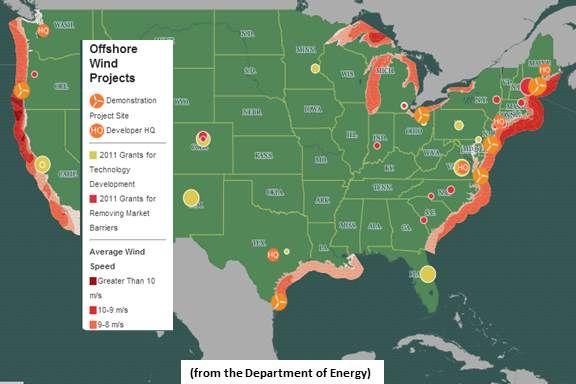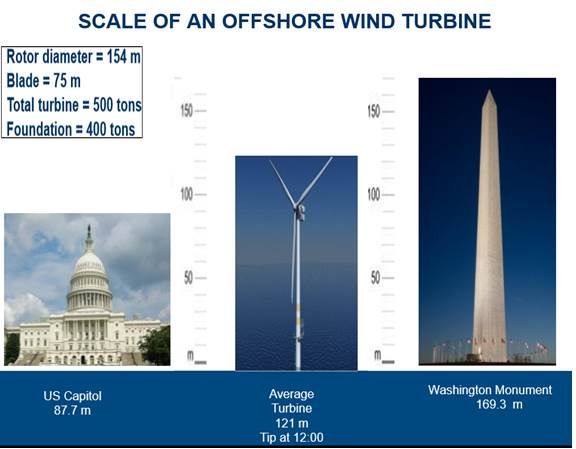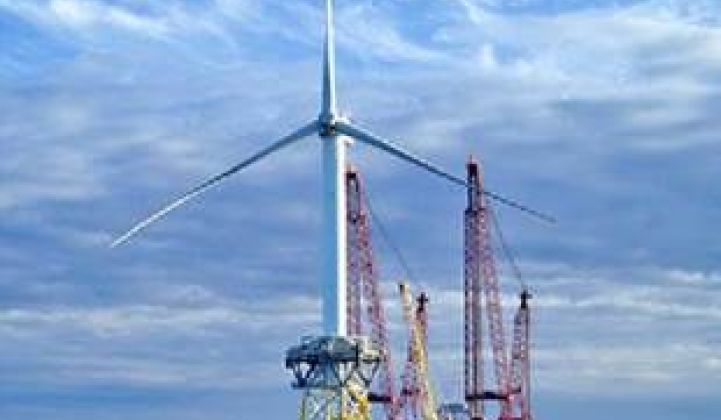There are thirteen U.S. offshore wind projects in ten states on the Atlantic, Pacific, Great Lakes and Gulf of Mexico coasts, representing 5,100-plus megawatts. None of the projects have started construction.
Here's an update on the status of those projects:
- Cape Wind: The fully permitted 468-megawatt project is planned for construction in Massachusetts’ Nantucket Sound by the end of 2013. It has PPAs for 77.5 percent of its nameplate capacity and the state is investing in port facilities.
- Block Island: Deepwater Wind’s 30-megawatt pilot project off Rhode Island’s Block Island has a PPA for 100 percent of its output and is now going through the permitting and approvals process. Construction could begin by the end of 2013.
- Wind Energy Center: Deepwater Wind’s proposed 1,000-megawatt project, twenty miles out to sea between Massachusetts and Rhode Island, has a lease application pending with the Department of the Interior's Bureau of Ocean Energy Management (BOEM).
- Hywind Maine Pilot Project: Statoil (STO)’s 12-megawatt pilot project will place four floating 3-megawatt turbines in 400-foot-deep Gulf of Maine waters 13.8 miles off the state’s coast. It has been approved by the Maine Public Utilities Commission and BOEM, and has a grant from the Department of Energy (DOE).
- Aqua Ventus: The University of Maine’s 12-megawatt pilot project will place two floating 6-megawatt turbines in the Gulf of Maine three miles off the coast of Maine’s Monhegan Island. It is supported by a DOE grant.
- Atlantic City Wind Farm: Fishermen’s Energy’s 25-megawatt pilot project located 2.8 miles off the coast of Atlantic City has all necessary state and federal permits and a DOE grant. It does not yet have a PPA, but New Jersey has an Ocean Renewable Energy Credit (OREC) system in place that is strong enough to support 1,100 megawatts of offshore wind. Construction will begin when financing is completed.
- Mid-Atlantic Wind Park: The NRG Energy-owned lease for a 300-megawatt to 450-megawatt project 13.2 miles off Delaware’s Rehoboth Beach had a 200-megawatt PPA, but it was canceled in 2011, and NRG is looking for investors or a buyer.
- Long Island-New York City Offshore Wind Project: The 350-megawatt to 700-megawatt project would be thirteen miles off the Long Island coast and co-funded by the Long Island Power Authority, Con Edison, and the New York Power Authority. It has an application pending with BOEM.
- Virginia Offshore Wind Technology Advancement: The Dominion Virginia Power-funded pilot project will install two 6-megawatt turbines 22 miles off Virginia Beach. It has a DOE grant.
- Icebreaker: The privately held Lake Erie Energy Development Corporation (LEEDCo)-funded, 27-megawatt pilot project will have nine 3-megawatt turbines seven miles into Cleveland Bay, in sight of the city’s shoreline. LEEDCo has a DOE grant and a lease-option from the State of Ohio, and just began installing its data-gathering tower.
- Gulf Offshore Wind: The Baryonyx Corporation, run by veterans of Europe’s wind energy industry, will build an 18-megawatt pilot project four to five miles off Texas’ Port Isabel in the Gulf of Mexico, with five 6-megawatt turbines.
- Rio Grande (North & South) Project: The Baryonyx Corporation also has development leases from the Texas General Land Office for a 2,000-megawatt to 2,400-megawatt project five to ten miles off Texas’ South Padre Island.
- WindFloat Pacific Demonstration Project: Principle Power plans a 30-megawatt pilot project for its floating turbines ten to fifteen miles off Coos Bay on the Oregon coast. It will start with three 6-megawatt turbines and is supported by a DOE grant.
- Atlantic Wind Connection: The 7,000-megawatt-capacity backbone transmission system for offshore wind projects will run from New Jersey to Virginia. It will be built by Trans-Elect, the Atlantic Grid Development coalition that includes Google, Inc. It has been cleared by BOEM, and New Jersey just announced a port facility renovation to streamline its construction.
Three of the thirteen projects have power purchase agreements in place:
- Cape Wind in Massachusetts (National Grid and NStar, 363 megawatts of 468 megawatts)
- Deepwater Wind in Rhode Island (National Grid, 30 megawatts)
- Statoil in Maine (Central Main Power Co., 12 megawatts)

Value of offshore wind:
- It provides high capacity-factor renewable energy adjacent to huge population centers.
- Its highest productivity is at peak demand periods.
The U.S. lags behind Europe and Asia:
- Europe: Europe has built 55 offshore wind projects in ten countries with 1,662 turbines and an installed nameplate capacity of 4,995 megawatts. There are fourteen projects just completed or under construction, which will bring Europe’s total to 8.3 gigawatts. It has set long-term goals of 40 gigawatts by 2020 and 150 gigawatts by 2030.
- Asia: China and Japan have operational projects with a combined estimated installed capacity of 544 megawatts. China completed a 150-megawatt project in late 2012. Japan’s offshore wind target is 8 gigawatts by 2030. China’s is 5 gigawatts by 2015 and 30 gigawatts by 2020. South Korea is targeting 600 megawatts by 2016 and 2.5 gigawatts by 2019. Taiwan has a goal of 3 gigawatts installed or under construction by 2020. Its government just approved three projects totaling 300-plus megawatts.
U.S. offshore wind costs:
- A U.S. utility-scale offshore project will likely have an average of 100 3-megawatt to 6-megawatt turbines and a nameplate generation capability of 300 megawatts to 600 megawatts. It will be built at an estimated cost of $1.5 billion to $3 billion.




